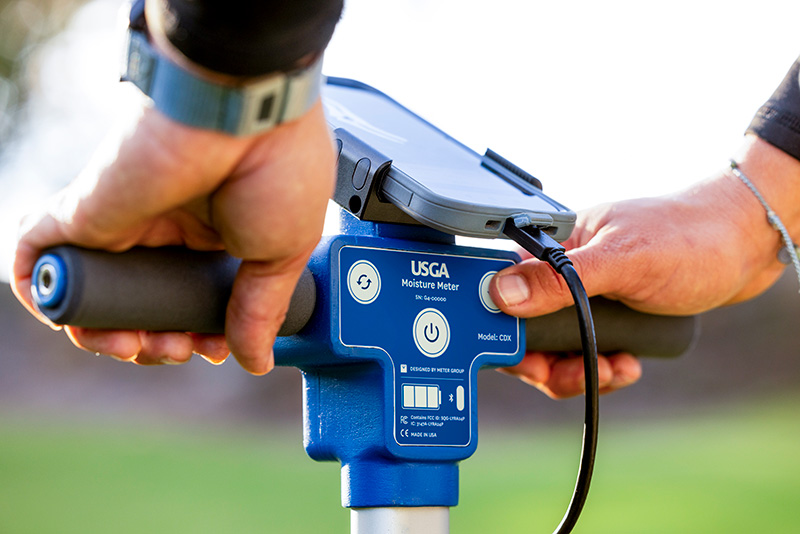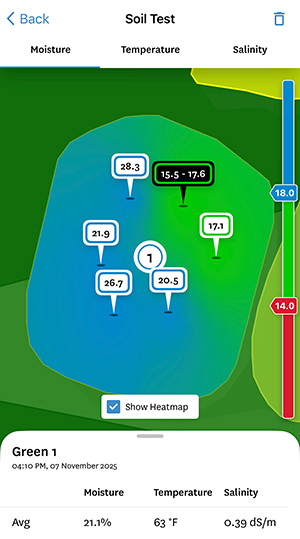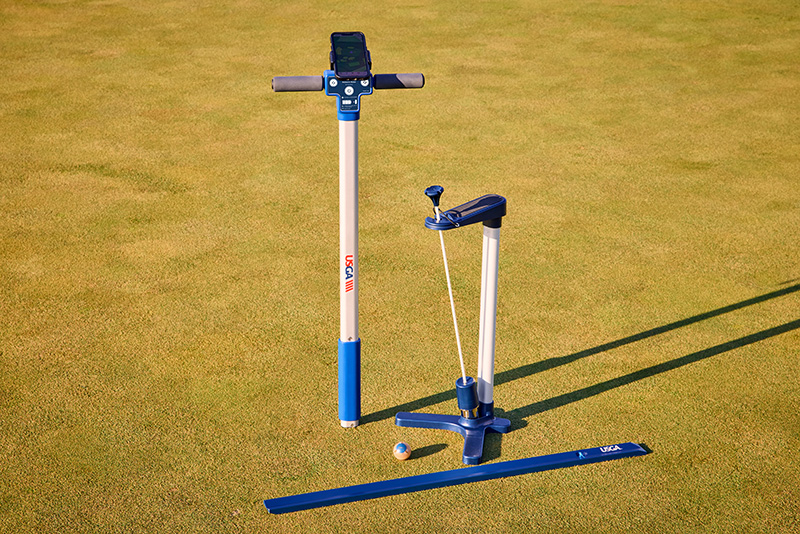
The USGA's new moisture meter is getting positive feedback from early users. Photos courtesy of the USGA
Editor’s note: The following article was supplied by the USGA. All product claims, research cited and other information is directly from the company.
One full golf season after the beta-test introduction of the USGA Green Section’s new moisture meter, the jury’s back in. As with its allied technologies, the GS3 ball and DEACON Management System, good luck finding naysayers.
“It appears they took all the models on the market, talked to all the users and asked them, If we were going to change anything, what would it be?” reports Robert Alonzi, CGCS, head superintendent at Fenway Golf Club in Scarsdale, N.Y. “The primary issue with all of these products was, you might get 3-4 different brand-new ones out of the box and they’d all read differently. With the USGA Moisture Meter, you take them out of the box, they’re already calibrated — and they all read the same. And they all sync up with the DEACON software, so all that data is funneled to one place.
“We started using the new moisture meter in March or April [2025]. The take-home message: They have gathered and blended all the best qualities in one high-quality device,” Alonzi says. “Battery life is great. Very ergonomically friendly if you’re a righty or lefty. It also has a protective slide that protects the tines. The others never did that. They put a lot of thought into this.”
While the pre-calibration aspect might be the most significant technological advance, the most meaningful overall benefit remains the moisture meter’s seamless integration with the entire system. As with the GS3 ball introduced in 2024, the USGA Moisture Meter gathers data and shares it automatically via Bluetooth to the DEACON app. The moisture meter and application, which runs on smart phone and computer, are available as a starter kit for an up-front investment of $3,000. Additional moisture meters can be purchased or added if you already have a DEACON subscription for $1,750.
For golf course superintendents, tools that measure water content in soils have been deployed and depended upon for decades. But regardless of make and model, they all came loaded with maddening baggage and limitations.
“With the meters we used to use, we had to calibrate every three weeks with distilled water and even then, each meter had its own scale,” says Jake Mendoza, head superintendent at Rich Harvest Farms in Sugar Grove, Ill. “There was no consistency from meter to meter. We had to learn which meter did what and account for it in every reading. With the USGA meters, there’s no calibration. They’re identical. No mental conversions required.
App display for the USGA's DEACON management system.

“We rely on the mapping portion of software a lot,” Mendoza continues. “In the past, we communicated that information by talking over the radio, or face to face: These are the numbers on this green. But we’ve found that looking at physical data — looking at the color-coded pin maps [Red = too dry, Green = in target, Blue = too wet] — has made things a lot easier. Instead of every guy with a unit, I have two guys who operate one moisture meter each. Then the irrigation guys come in behind. It’s just so much easier to communicate within the team, and ultimately to that irrigation team, on what we’re seeing moisture-wise.”
Andrew Hart, superintendent at Shaughnessy Golf & Country Club in Vancouver, British Columbia, is spending a lot of time at home these days, looking after a newborn alongside his wife. As such, he’s been continually struck by how much time the moisture meter saves him — or rather, how much time he used to spend gathering moisture-related information from his colleagues, then sharing it with the team.
“The data is going straight from the device into the app. That’s my favorite thing,” Hart says. “Ours has become a more and more data-driven industry over last 15 years, and I’ve always found it hard to gather and dedicate the time to input data in office and be able to read it with concrete results. This is instantly recording all the data in the ways that I would want, while color coding thresholds for low moisture, target moisture, etc. It’s really great to throw that information up at a board meeting — it allows you tell a story, or you can go with a grid that helps you track things, for any day or time period. It totally removes the middle data-input stage.”
Hart explained that, of late, with a newborn, he can’t always be on site every single morning without fail. The moisture meter specifically, and DEACON more broadly, have changed his mornings.
“When you wake up, you want to know what’s happening on the golf course. Typically, that used to mean sending a mass text to the management team, getting responses and formulating a further response,” Hart says. “Now I just pop on the DEACON app and I’m seeing my team already has the moisture readings. It’s all there on my phone, in two seconds, before I get out of bed. That’s a time saver but I can also ask more pointed, better questions with that info.”

The USGA's moisture meter is pre-calibrated and ready to work with other USGA tools and the DEACON app.
In addition to the big picture, Hart was impressed with the smaller details that distinguish and ultimately recommend the new moisture meter. Things like those tine sleeves that “slip easily on and off,” protecting sensitive data sensors from jiggling around in the back of a utility vehicle. And the slide-apart phone clip, as one’s smartphone must be connected to the app to instantly transfer the data.
“The instrumentation we found to be really user friendly. It pulls GPS right off your phone to mark the reading,” Hart says. “On the first green, you select ‘Green 1,’ take all your readings and the GPS is just going to place that for you. You can place it manually and I have a couple guys who do that, to ‘grid out’ the green.
“But while they’re doing all this, they’re getting a phone charge — from the battery on the meter. Pretty nice perk.”
Hart and Mendoza both report that they didn’t need to replace any tines during the 2025 season — a fact that distinguished USGA’s model from other meters.
“The tines themselves seem to hold up a lot longer,” Mendoz says. “We haven’t had to change them out. The card provided to test the tines — to see if they’re still within performance spec — says that’s just not happened yet. On both our meters, the tines are still straight. We’ve tried all sorts of mounts through the years. Never found a good solution, but these mounts are great and that means a lot.”
Mendoza, like Hart, loves the communication upgrade. “Even when I’m on site, I don’t have to take the time to make that radio call, What are your numbers? I pull up the numbers and see exactly what they see in the field and what changes we should make to the watering plans for the day,” Mendoza says. “All the guys on the management team can look at the data at any time for afternoon water-checks: comparing morning to afternoon, checking to see what water’s been lost on each green. That’s huge to our planning for overnight water and getting through that afternoon stress. No searching for info. It’s all right there.”

Other USGA tools include the DEACON management system and the GS3 Ball.
Time saved is important, but each of the three superintendents emphasized that all the readings taken by the new moisture meter are shared to DEACON — along with all the GS3 data. This functionality creates a digital record that’s stored in cloud, accessible in DEACON and available for studying and future benchmarking. Barely a year into the USGA Moisture Meter era, superintendents are just scratching the surface of what that particular data can and will inevitably tell them.
According to Alonzi: “If it’s a high sky, dry and breezy, I can just open the app, see where the greens are and whether we need to start making some water adjustments… After a rain event, if we want to compare what typically happens afterward, for how long, we can go back, open up the software, pick the day and be more sure about how to proceed. Like, Hey, we were having irrigation issues, or This particular green is, in fact, reflecting what everything else is telling us.”
In Illinois this fall, “We are about 11.5 inches behind average rainfall this year,” Mendoza reports, “and that’s borderline extreme drought per the national weather service. This year, it was easier to make the decision about when to water after a big rain event, because we’re looking at data regarding the last time we had at least an inch of rain. That sets up the time frame for the next rain event, which, in my opinion is one of the hardest things we do. This stored moisture data made that process easier.
“The biggest thing is the way it automatically collects data and stores it without adding something extra to your day. The ability to refer meaningfully to that historical data has already made such a big difference for us.”
Hal Phillips is the managing director of Mandarin Media and a frequent contributor to GCM.